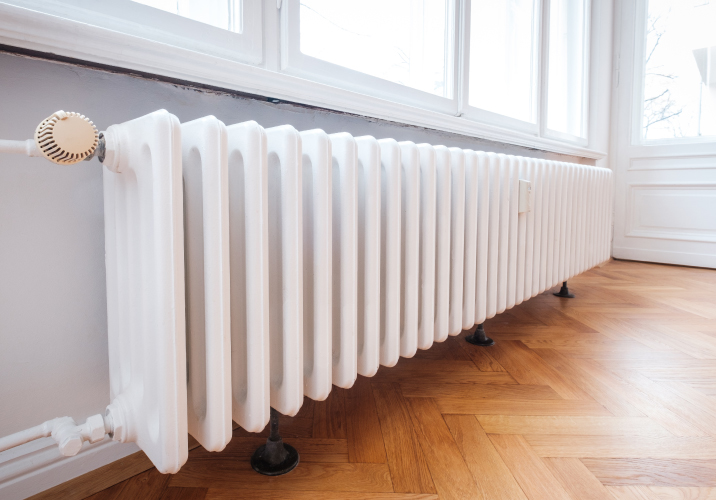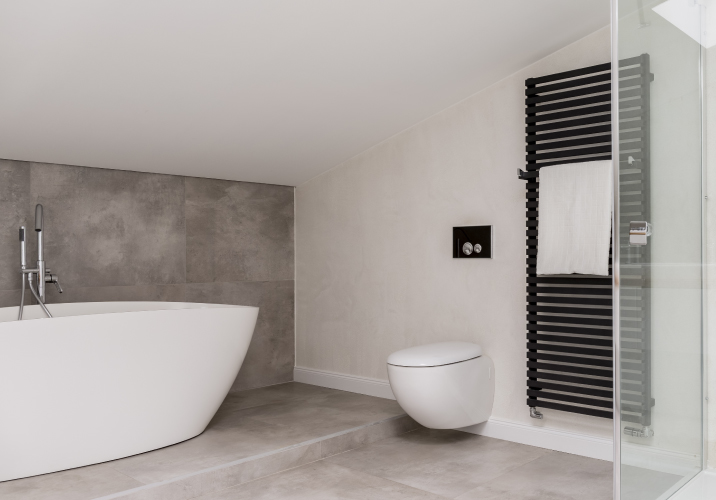
Find a local air conditioning and heating expert
- Inspiration /
- Indoor projects /
- Heating & cooling /
- What is hydronic heating?
What is hydronic heating?
The home heating solution you need to consider
Hydronic heating is one a popular method of heating a household by circulating boiling water through closed pipes. It works by heating water in a boiler until it becomes pressurised in specially designed pipes that then radiate heat where you need it. The warmth from hydronic heating all relates to how warm the water is. The water needs to be heated to make the room warm, which is done before it reaches the pipes.
The radiators will last indefinitely if properly maintained, and homeowners can also get heated towel rails for their bathrooms that use hydronic heating.
Here, we’ll give you the complete run down on hydronic heating, so you can decide if it’s the right heating solution for your home.

Benefits of hydronic heating
1. Versatile & efficient energy sources
A lot of heaters are surprisingly wasteful, but hydronic heaters use gas boilers, which can be as much as 95% efficient. The water that is circulated through the home is first heated inside the boiler – which can be powered with an electric, geothermal, natural gas, solar, or most commonly a gas-powered pump. With the ability to operate on several different power sources, the versatile nature of a hydronic system can be the perfect solution for even the most frugal or environmentally conscious of consumers. Safety: The fact that the external panels that radiates the heat doesn’t get hot enough to burn means small kids and innocent pets are safe being around a hydronic heating system.
Plus, being one of the more economical forms of heating, owners are able to set the temperature slightly lower than they normally would and still maintain the desired level of comfort.
Pro tip: Using radiators with low water content will save even more energy.
2. Reliability
With anything you install in your home, you need it to be reliable. But, it is a bonus when you find a reliable unit that is also low maintenance. Hydronic heating offers that solution.
Aside from the power options, the reliability and effiiciency of a hydronic heating unit become apparent when you have the ability to set temperatures based on the area of the home you want to be heated. Hydronic heating works by using zoning, heating only the areas of the house that are most used, rather than warming areas where no one is. You control the thermostats that maintain the temperature, so you’re always comfortable. Hydronic means water, but none is wasted in the cycling system that recirculates well enough so that you only add a bit of water once a year.
3. Safe for the whole household
Unlike other heating units, the hydronic heating system does not use fans to blow the heated air. Without these fans circulating things like allergens, dust, bugs, and pollen that can irritate allergies or asthma conditions, your home’s air will be cleaner. Hydronic heating gently warms the water, which circulates to radiators for a calm and healthy environment that’s neither humid nor dry.
In addition to being allergen-friendly, hydronic heating also poses very little by way of a fire hazard, is safe to touch and there are no electrical connections to worry about.
4. Comfort
The gentle, spreading and even heat of hydronic heating makes it especially comfortable. No more bursts of oppressively hot air. Instead, the warmth radiates up through the floor to strategically located radiators for a constant and consistent temperature. If the air starts to go cool or get too warm, the specialty thermostats recognise the change and immediately adjust the temperature. You can leave the heater running all through the cold season without feeling uncomfortable about the air or the bills.
5. It looks good
Most people expect their heating systems to be a bit of an eyesore, but the radiators that are used with hydronic heating systems are available in a wide variety of colours, designs and styles to compliment your decor. If you’re not into the decorative radiators, you can opt for the floor heating, which is completely hidden from view and located within the piping beneath the floorboards. Stylish and practical, hydronic heating is poised to completely overtake other systems.

Different types of hydronic heating
There are a number of options when it comes to hydronic heating. Aside from what energy source you’ll use, the other main choice is between hydronic floor heating and hydronic wall heaating.
Hydronic wall heating
In this type of hydronic heating the hot water runs through pipes to these radiators or panels on the walls throughout the home. This is the most economical version because installation won’t require removing and replacing flooring.
Hydronic floor heating
Hydronic floor heating warms the floor of your home by heating the pipes beneath the surface. The pipes heat will warm the floor, making the whole room warmer as the heat rises. Whether your floor is made of slabs, screed or timber, it will work well with hydronic floor heating. There are a few different types of hydronic floor heating:
Slab hydronic floor heating: In this system, the heating system is laid directly into the concrete slab of the floor. Rugged plastic pipes joined with leak-proof fittings distribute the heated water throughout the house. The temperature of the system is controlled with specially-designed air-sensing thermostats. A slab hydronic system may take as long as a day or two to sufficiently warm the slab flooring, but once it has begun, the system will continuously radiate heat throughout the room during the entire winter.
Screed hydronic floor heating: This system works in a similar way to slab hydronic floor heating, except that the plastic pipes are placed on the topping screed of the concrete flooring, rather than embedded inside it. This system mitigates construction delays and is much quicker to install, because the pipes arent installed directly within the poured concrete. In addition, a screed hydronic system heats up and cools down much more quickly because of the pipes being on top.
You can also choose to have hydronic floor heating installed underneath battened timber floors. This type of system uses plastic pipes that are installed over insulation panels directly below the floorboards. The pipes run securely through the battens, and the water temperature is controlled by a floor thermostat. The difference, however, is that this type of thermostat is typically set at a maximum 27 degrees Celsius so as not to damage the timber floors.
In addition to timber and concrete slab flooring, hydronic floor heating can be used under tiles, linoleum, rugs and carpeting.
Which hydronic heating system is right for you?
So what do you need to consider when choosing a hydronic heating system? It depends on a few things, the most important of which is how you power your boiler. Youll need to check the advantages and disadvantages of each. An example of this is that although solar power is the cheapest option, a backup may be needed for when it doesnt provide your home with as much energy as it needs. Gas is also fairly cheap and comes with a number of choices, such as LPG or natural gas. On the other hand, the price of gas can vary over time and may become more expensive in the following years.
Finally, it is worth considering the aesthetics of your boiler. The great thing about hydronic floor heating is that it is invisible – you wont see any evidence of it after installation is complete. With radiators, panels will be visible around the room, but you can choose what style you like. In some ways, this can really enhance a rooms appearance.
When considering installing this heating technology, it is important to work in conjunction with an architect or designer to ensure it will fit with your new home design. If planning to instal it in an existing home, work closely with a hydronic heating company. The company can help you decide the location for the instal, the type of system, the number of heating zones, the location of thermostats and the ideal temperatures achieved from the heating.
Installing hydronic heating
Since hydronic heating is a special type of system, it must be installed by a registered expert. The supplier should be able to provide an installer to construct the boiler (needed for heating the water), pipe work (floor or walls), radiator, temperature sensors, and thermostats.
Installation costs will depend on a variety of factors so you should therefore assess your personal requirements and budget, and have a specialist design a system that will meet your needs. He or she can also choose the ideal method of powering the system, which will reduce running costs. Always ask for a quote before work begins.
While it’s best to install hydronic heating during a new home build, it can also be retrofitted if required.
Related posts
How much will your job cost?
The Oneflare Cost Guide Centre is your one-stop shop to help you set your budget; from smaller tasks to larger projects.



